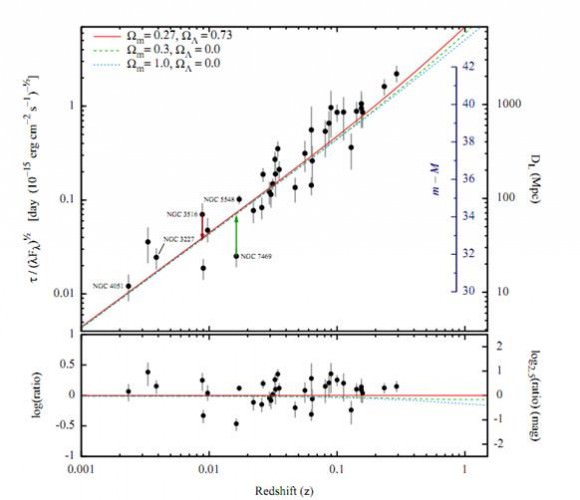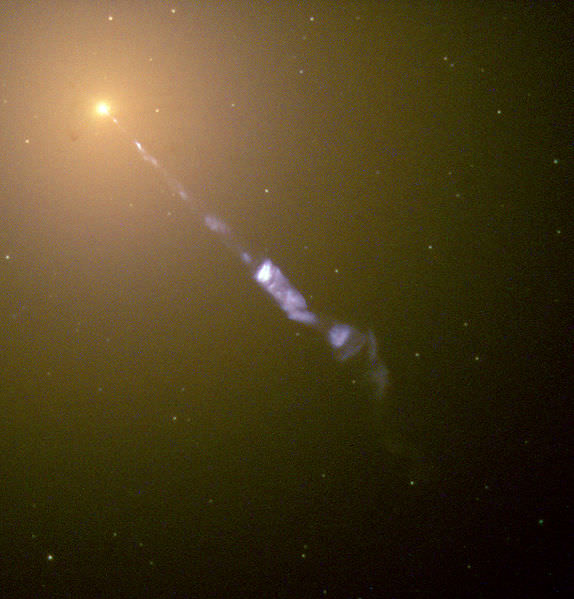[/caption]
Nope. A standard candle isn’t the same red, green, blue, yellow and omni-present pink wax sticks that decorate your every day birthday cake. Until now a standard candle meant a Cepheid variable star – or more recently – a Type 1a supernova. But something new happens almost every day in astronomy, doesn’t it? So start thinking about how an active galactic nucleus could be used to determine distance…
“Accurate distances to celestial objects are key to establishing the age and energy density of the Universe and the nature of dark energy.” says Darach Watson (et al). “A distance measure using active galactic nuclei (AGN) has been sought for more than forty years, as they are extremely luminous and can be observed at very large distances.”
So how is it done? As we know, active galactic nuclei are home to supermassive black holes which unleash powerful radiation. When this radiation ionizes nearby gas clouds, they also emit their own light signature. With both emissions in range of data gathering telescopes, all that’s needed is a way to measure the time it takes between the radiation signal and the ionization point. The process is called reverberation mapping.
“We use the tight relationship between the luminosity of an AGN and the radius of its broad line region established via reverberation mapping to determine the luminosity distances to a sample of 38 AGN.” says Watson. “All reliable distance measures up to now have been limited to moderate redshift — AGN will, for the first time, allow distances to be estimated to z~4, where variations of dark energy and alternate gravity theories can be probed.”

The team hasn’t taken their research “lightly”. It means careful calculations using known factors and repeating the results with other variables thrown into the mix. Even uncertainty…
“The scatter due to observational uncertainty can be reduced significantly. A major advantage held by AGN is that they can be observed repeatedly and the distance to any given object substantially refined.” explains Watson. “The ultimate limit of the accuracy of the method will rely on how the BLR (broad-line emitting region) responds to changes in the luminosity of the central source. The current tight radius-luminosity relationship indicates that the ionisation parameter and the gas density are both close to constant across our sample.”
At the first standard candle we discovered the Universe was expanding. At the second we learned it was accelerating. Now we’re looking back to just 750 million years after the Big Bang. What will tomorrow bring?
Maybe a new kind of cake…
Original Story Source: A New Cosmological Distance Measure Using AGN.


Interesting. Wouldn’t have thought that something like this could be possible, giving the non-“standard” nature of AGNs, with all that flickering and flaring.
What I am not quite sure of is, where that first flare has to come from. Probably from the accretion disk, since, when it comes from the jet, the distance between the flaring region and the BLR would be highly uncertain.
Maybe I should read the paper. 😉
Slightly OT, but – as for M87 and it’s 1,5 kpc jet (pictured at the top) – why jet is not visible on the other side of the galaxy? BHs jets are bipolar, right? Is it completely obscured by the AGN?
This is due to relativistic effects. Fast moving particles push their radiation strongly into the forward direction. This is called relativistic beaming, and also the reason why we only see one jet. The other one is there, but due to the beaming (the particles rush away from us!) almost no radiation is pointed at us.
yes, there is also the polar orientation and it’s incidence to us.
the rate of infalling matter and the amount of obscuring material.
what’s the effect on all those stellar systems in the direct path of those jets?
Well I think they must be having some nice auroras for sure… 😛
They are probably fried to death. 😉
But nice auroras, yeah. 😀
What I find fascinating is where the collimation of the jet’s plasma stream seems to break down – estimated to be 2 kilo-parsecs from the source! The strength of the magnetic field that confines that beam seems beyond comprehension… i.e. WOW! Dats a BIG Black Hole in our universe! One ‘hell’ of an energy fountain anyway – eh?
Hopefully, this model will help confine just how big and just how much energy is required to power similar jets…
The magnetic field is not as strong as you might think. It’s probably on the order of a few Gauss or less. At least, it is some orders of magnitudes lower than the magnetic field we need to confine particles in, e.g., the LHC. But that’s, because we want the particles to go in circles. In a jet they are mostly flying straight ahead.
Actually, it is not clear how a jet forms and gets collimated over such long distances. The velocity of the particles certainly plays a role. But the actual causes and effects are a matter of quite active research.
So… not the strength, but the size of the mag. field that’s important?
Well, honestly, I can’t tell what’s the most important effect to collimate jets over such distances. You must also consider the surrounding gas and its pressure on the jet.Since a fast moving gas has a lower pressure than a gas at rest, this may even be the most important effect.
But, as I said, I don’t really know. And, it’s a field of active research, and no definitive picture can be drawn (apart from some very good ideas ;)).
Some of that active research has resulted in the following entry in the wiki — where you see the words background, toward the top of the article.
http://en.wikipedia.org/wiki/Gravitomagnetism
Mary